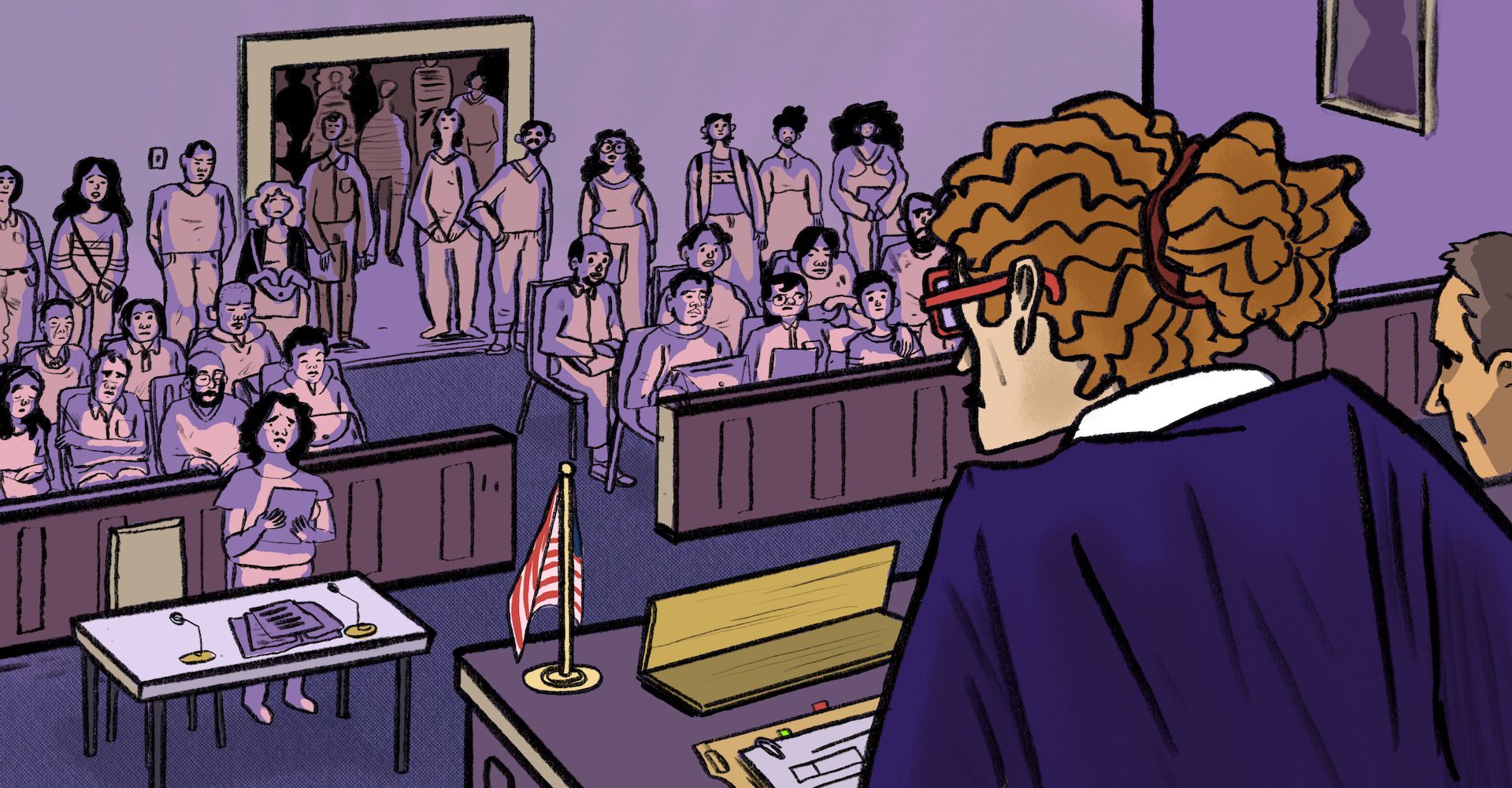 Illustration by Mike Centeno for Borderless Magazine
Illustration by Mike Centeno for Borderless Magazine Under Trump, immigration policies are rapidly changing. Borderless Magazine compiled a guide to explain removal proceedings, detainee rights and potential risks.
Since returning to office, President Donald Trump’s sweeping immigration crackdown has arrested more than 30,000 immigrants and deported over 139,000 people, according to Border czar Tom Homan.
In the first three months, Trump has also signed a flurry of executive orders that narrow the pathway to legal status for immigrants. Amid the rapid upheaval, legal experts say the deportation process is becoming increasingly difficult to navigate without proper guidance.
“Immigration law and the paths leading to it are complex,” said Bradley Jenkins, managing attorney at the Amica Center for Immigrant Rights. “When everything is so complicated, you have to have the ability to present your case to correct errors, to have legal help.”
News that puts power under the spotlight and communities at the center.
Sign up for our free newsletter and get updates twice a week.
Borderless Magazine put together a guide on recent immigration policy changes, the removal process, who may be at risk and detainee rights.
This article is for educational and informational purposes only and should not be construed as legal advice.
What changes have been made to immigration policies?
Since January, Trump has taken direct aim at the United States’ immigration system through a series of executive orders. Among the changes, Trump has attempted to:
- end birthright citizenship — a right enshrined in the Constitution;
- Attempted to cancel temporary status’ for those who arrived in the U.S. from Cuba, Haiti, Nicaragua and Venezuela through Biden-era temporary parole programs;
- invoked the Alien Enemies Act to deport hundreds of Venezuelans;
- shutdown the U.S. Customs and Border Protection (CBP) mobile app scheduling function for individuals seeking asylum functions;
- attempted to revoke visas for international students engaged in anti-war protests on college campuses; and
- proposed a travel ban that revived his 2017 travel ban but widened its scope, impacting more than 40 countries, several being in Asia and Africa.
While some of Trump’s executive actions have faced legal challenges, many of these policies have created uncertainty for many immigrants with various legal statuses.
Who is subject to deportation?
The Trump administration has cast a wide net on individuals they are seeking to deport. Among those who can be targeted are:
- people who entered the country without proper documentation
- individuals who arrived legally and overstayed their visas
- noncitizens who have been convicted of a crime
- individuals who had their temporary protected status removed by the administration
Attorney Jenkins says that in order to prove someone is eligible to be deported, the government must prove that they are not a U.S. citizen and that they violated immigration law. However, people may still be eligible to apply for relief from removal through applications like asylum or withholding of removal. These are available for individuals facing persecution or violence if sent back to their home country.
What happens in the deportation process?
The deportation process starts when ICE suspects an individual is “removable,” according to NPR. After being taken into custody, an individual may be released or detained for up to 48 hours in a local jail or prison.
Depending on the case, they could be released on bond or transferred to an ICE detention center. In either case, they’ll receive a “Notice to Appear,” or NTA, which is what the immigration court sends you to inform you of your removal proceedings and the charges against you by the Department of Homeland Security. Removal proceedings are also known as deportation proceedings. The NTA letter also states that you are required to appear in immigration court.
When the individual appears in court, the judge decides whether the individual is removable based on evidence.
Through this process, if the individual fits a certain criterion, they could defend their case through a variety of waivers, including:
- asylum, which grants individuals who have a well-founded fear of persecution if returned to their home country;
- withholding of removal, which offers protection for those who do not qualify for asylum but would still face danger if returned to their home country;
- cancellation of removal, which allows an immigration judge to “cancel” a finding of removability and grant lawful permanent U.S. residency; and
- convention against torture, which provides protection for those who face a credible risk of torture if returned to their home country.
As of February, 3.6 million immigration cases remain backlogged, according to The Transactional Records Access Clearinghouse (TRAC), a data gathering, data research and data distribution organization.
What happens in the removal process?
If a person is unsuccessful, a final removal order is issued and a person may leave the country voluntarily, according to NPR. They might also face expedited removal, which typically happens at the border. Others may wait for removal, which is often delayed by court backlogs and capacity issues.
During their removal, some can either make their own travel arrangements and leave or walk back across the border through a voluntary return. A nonvoluntary removal would involve departing in government custody and boarding a commercial or military flight accompanied by an officer, according to NPR.
The individual would either be returned to their home country or go to a third-party country.
What are my rights if I’m detained?
Everyone in the United States, regardless of their status, has constitutional rights that should be followed by governmental institutions like ICE. For instance, those who are detained still have the right to remain silent, the right to refuse being searched and the right to hire a lawyer. The government does not need to provide an attorney for immigration hearings.
Trump has faced challenges from federal judges and the Supreme Court for deporting Kilmar Armando Abrego Garcia due to an “administrative error.” In a ruling, the Supreme Court ordered the Trump administration to facilitate his return.
Read More of Our Coverage
More recently, two U.S. citizen children were deported with their mother to Honduras – leaving one without access to medication for their rare form of cancer. They were not given the opportunity to speak with attorneys.
“Due process is not a suggestion or a privilege afforded to a select few – it is a fundamental right guaranteed to all under the United States Constitution,” the Congressional Asian Pacific American Caucus said in a statement demanding that Trump uphold due process. “For over two centuries, this principle has ensured that no person – citizens and noncitizens alike – is deprived of life, liberty, or property without a fair trial.”
Further resources are available on Borderless Magazine’s resource guide about what immigrant communities should know about their rights.
When is it best to consult a lawyer?
It is best to consult a lawyer familiar with your case as soon as possible for specific guidance on your fears of being detained. Attorneys can give you informed advice about your rights and how to proceed based on your specific case.
Additional information on when to seek an attorney is available in Borderless Magazine’s explainer.
This article is for educational and informational purposes only and should not be construed as legal advice.
Tara Mobasher is a Northwestern Medill Reporting fellow at Borderless Magazine. Email Tara at [email protected].


